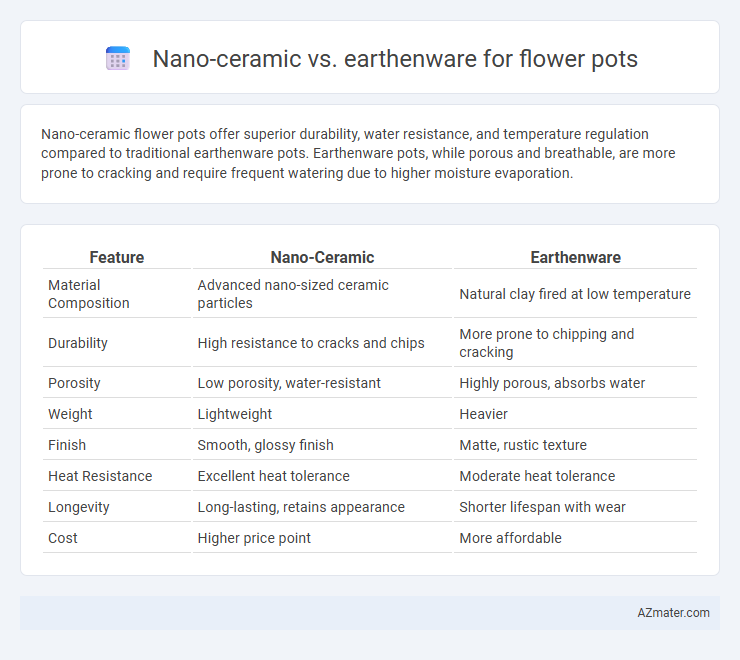Nano-ceramic flower pots offer superior durability, water resistance, and temperature regulation compared to traditional earthenware pots. Earthenware pots, while porous and breathable, are more prone to cracking and require frequent watering due to higher moisture evaporation.
Table of Comparison
| Feature | Nano-Ceramic | Earthenware |
|---|---|---|
| Material Composition | Advanced nano-sized ceramic particles | Natural clay fired at low temperature |
| Durability | High resistance to cracks and chips | More prone to chipping and cracking |
| Porosity | Low porosity, water-resistant | Highly porous, absorbs water |
| Weight | Lightweight | Heavier |
| Finish | Smooth, glossy finish | Matte, rustic texture |
| Heat Resistance | Excellent heat tolerance | Moderate heat tolerance |
| Longevity | Long-lasting, retains appearance | Shorter lifespan with wear |
| Cost | Higher price point | More affordable |
Introduction: Choosing the Right Flower Pot Material
Nano-ceramic flower pots offer superior durability and water resistance compared to traditional earthenware, making them ideal for both indoor and outdoor use. Earthenware pots provide excellent breathability and natural insulation but are more porous and prone to cracking over time. Selecting between nano-ceramic and earthenware depends on factors like plant type, watering frequency, and environmental exposure.
What is Nano-Ceramic? Understanding the Innovation
Nano-ceramic flower pots utilize nanoparticles to create a durable, water-resistant surface that enhances soil moisture retention and reduces root rot compared to traditional earthenware. This innovation in ceramic technology improves pot strength and longevity through advanced molecular bonding, offering superior resistance to cracks and environmental stress. Unlike earthenware, nano-ceramic materials provide a non-porous finish, optimizing plant health by minimizing water loss and promoting a stable growing environment.
Earthenware Explained: Tradition and Functionality
Earthenware flower pots, crafted from porous clay fired at lower temperatures, have been used for centuries due to their natural breathability and moisture regulation, promoting healthy root growth. This traditional material excels in allowing air and water to pass through the pot walls, preventing root rot and overwatering, unlike nano-ceramic pots which are typically denser and less porous. Earthenware's rustic aesthetic combined with its functional benefits makes it a popular choice for gardeners seeking both durability and natural plant care.
Durability: Nano-Ceramic vs Earthenware Performance
Nano-ceramic flower pots exhibit superior durability due to their dense, non-porous structure that resists cracking, chipping, and weather damage better than traditional earthenware. Earthenware pots, being more porous and less compact, are prone to moisture absorption which weakens their structural integrity over time, especially in freeze-thaw cycles. The enhanced hardness and thermal stability of nano-ceramic materials ensure prolonged lifespan and consistent performance in various environmental conditions compared to earthenware.
Porosity and Water Retention: How Materials Affect Plants
Nano-ceramic flower pots exhibit significantly lower porosity compared to earthenware, resulting in superior water retention that benefits plants requiring consistent moisture levels. Earthenware's porous structure allows for enhanced aeration and faster drainage, ideal for plants prone to root rot in overly damp soil. Understanding these material properties enables gardeners to select pots that balance moisture control and airflow, optimizing plant health and growth conditions.
Weight and Portability: Ease of Handling
Nano-ceramic flower pots are significantly lighter than traditional earthenware, enhancing portability for gardeners who frequently relocate their plants. The reduced weight of nano-ceramic pots allows for easier handling and transport without compromising durability or aesthetic appeal. Earthenware pots tend to be heavier and more fragile, making them less convenient for users who need lightweight and portable planting solutions.
Aesthetic Appeal: Design and Color Options
Nano-ceramic flower pots offer a sleek, modern aesthetic with vibrant, glossy finishes and intricate detailing due to their advanced material technology. Earthenware pots feature a rustic, natural charm with warm, earthy tones and a variety of handcrafted textures that enhance garden and indoor environments. The design versatility in nano-ceramic pots often includes bold colors and smooth surfaces, while earthenware emphasizes traditional, matte finishes and organic hues, catering to different stylistic preferences.
Environmental Impact: Sustainable Choices
Nano-ceramic flower pots offer enhanced durability and longevity, reducing the frequency of replacement and minimizing waste. Earthenware pots, made from natural clay, provide excellent biodegradability, making them eco-friendly at the end of their life cycle. Choosing pots with recyclable materials and low environmental footprints supports sustainable gardening practices and conserves resources.
Cost Comparison: Upfront and Long-Term Value
Nano-ceramic flower pots generally have a higher upfront cost due to advanced materials and manufacturing techniques compared to earthenware pots, which are more affordable initially. In the long-term, nano-ceramic pots offer superior durability, resistance to weathering, and reduced risk of cracking, leading to lower replacement frequency and maintenance costs. Earthenware pots may require more frequent replacement due to fragility but remain a budget-friendly choice for short-term use or seasonal planting.
Which is Better for Your Plants? Final Considerations
Nano-ceramic flower pots offer superior moisture retention and durability, promoting consistent hydration for plants, while earthenware pots provide natural breathability, enhancing aeration and root health. The choice depends on your plant's specific needs: nano-ceramic is ideal for moisture-loving plants, whereas earthenware suits drought-tolerant species requiring better air circulation. Consider factors like watering frequency, plant type, and environmental conditions to determine which pot material optimizes growth and longevity for your garden.

Infographic: Nano-ceramic vs Earthenware for Flower Pot
 azmater.com
azmater.com